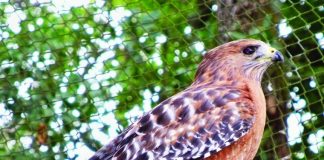March 20 heralds the arrival of spring and nature is blooming with new life, both floral and faunal. Nesting season also begins and typically continues through August. Unfortunately, every year the Wildlife Education and Rehabilitation Center and other wildlife rehabilitation facilities across the nation receive thousands of baby birds, rabbits and tree squirrels because they have lost their nests or been injured due to yard and home maintenance, such as these three little barn owlets who were knocked out of their nest in a palm tree that was being pruned.
A what year for what? Many of our feathered friends from Canada are enjoying the relative warmth, sunshine and especially the abundant food of South Valley this winter.
The first person who called the Wildlife Education and Rehabilitation Center last month to report an injured juvenile herring gull in Gilroy thought the bird had been shot in the face with a pellet gun. A short while later, another call was received about the same gull from a person who believed it to have been hit head-first by a vehicle.
Every summer and fall the Wildlife Education and Rehabilitation Center in Morgan Hill receives calls from well-meaning people who have taken in an orphaned baby animal (often a bird) in the spring, and raised it in their home. The animal is now grown up and the caller wants to know where and how it should be released.
Do not feed the birds … hamburger, spaghetti, Cream of Wheat, filet mignon, mashed potatoes.
’Twas the fortnight before Christmas when Steve Johnson was putting up festive Christmas decorations outside his home in San Martin and witnessed something strange going on in the field next door. Walking over, he discovered an injured juvenile peregrine falcon on the ground, with some turkey vultures circling it with curiosity. Steve rescued the 15-inch long raptor and brought it to the Wildlife Education and Rehabilitation Center.
One of our local avian citizens has some wonderful people for whom to be thankful this year. At a field near downtown Morgan Hill last month, it's believed that this red-shouldered hawk was being attacked by a pair of much larger red-tailed hawks, who knocked the competing red-shoulder to the ground and badly bruised her wing. After being rescued and transported to the Wildlife Education and Rehabilitation Center, the hawk's exam showed that the right wing had painfully limited extension and the hawk could not stand well, but instead would totter over onto her side. A more visible and serious injury was feared – her left eye was covered by thick mucus surrounding the cornea. WERC staff cautiously cleansed the eye with warm water, which moved the tip of a foreign object into view. With tweezers, two foxtails were delicately removed from under the top eyelid and from the inner corner of the eye. Apparently, the hawk's desperate flailing on the weed-covered ground had allowed the offending foxtails to enter the eye, causing the secondary injury.
The Wildlife Education and Rehabilitation Center held its 17th annual Barbecue and Auction Saturday. The organization uses this event to not only recognize its sponsors and volunteers, but also allow the public to bid on various donated prizes in auction while educating them to respect nature.
Like an autumn leaf gliding on a breeze, a male kestrel gracefully floats over the bare field, waiting for a glimpse of an appetizing field mouse. His chestnut-colored back and tail and silvery-gray wings make him one of the most colorful of the raptors, a beautiful sight against a dreary October sky.
The Baltimore baseball team may have the orange and black colors of their namesake bird, the Baltimore oriole, but these baby Bullock's orioles, which (if they're male players) will also grow up to sport bright orange breast feathers and black caps, appear to be cheering on their own local team, the San Francisco Giants.


















